Let me tell you a story today. A story about a wise monk. Why do you ask? Well, to learn a moral lesson for the Chief Marketing Officer.
There lived a wise monk in a monastery, who sent five of his disciples to a distant tribal village to spread valuable lessons.
The monk asked the disciples to reach their destination and send him a letter.
Witnessing such a confusing situation, the monk’s attendant enquired why he sent five disciples instead of one because the task was easy. The monk remained silent.
Out of the five, only one of the disciple reached the village. As instructed, he sent his master a letter stating about his arrival in the small town. And thinking about what happened to the others? Well, the road to the village was not easy. Filled with treacherous mountains, menacing jungles, and precarious rivers, other travelers lost their way before they could find the town.
The one who reached the village carried the words of his teacher and helped educate many in the area.
Now, think from a marketing point-of-view. The Chief Marketing Officer (CMO) is like the monk, the disciples are the different marketing campaigns, the road is sales funnel, and the village stands for your customers.
As a CMO, you will plan different marketing campaigns. However, only one or maybe two will reach your targeted audience. The sales funnel as treacherous as the road that the disciples had to undertake. It was not safe, filled with challenges. Expecting every campaign that you formulate to work out is plain stupid. The sales funnel will try and test everything you know and everything you expect. And only the most effective will reach your customers.
The wise monk took a calculated step because he had anticipated the challenges. He knew that to make his message reach a distant village, he had to take risks. Similarly, a CMO who updates and adapts to the present and future trends takes calculated risks can reach out to the remote target audience, efficiently.
Who is a Chief Marketing Officer?
A Chief Marketing Officer (CMO) supervises, manages and controls an organization’s marketing and advertising initiatives. Now, given that technology is an essential aspect of marketing, it is only expected that a person responsible for it should know the nitty-gritty of the same.
A CMO must strengthen himself/herself on five technological fronts to stay updated with the industry standards. In a fiercely competitive marketing landscape, not being at par with the work can harm individual careers.
Moving on, the role of CMO is undergoing a drastic change. To fit themselves to the on-going change, every CMO needs to adapt to the new technologies.
Also read: The Dynamic Role of a CMO
The five technologies a CMO can utilize for boosting his/her marketing skills are:
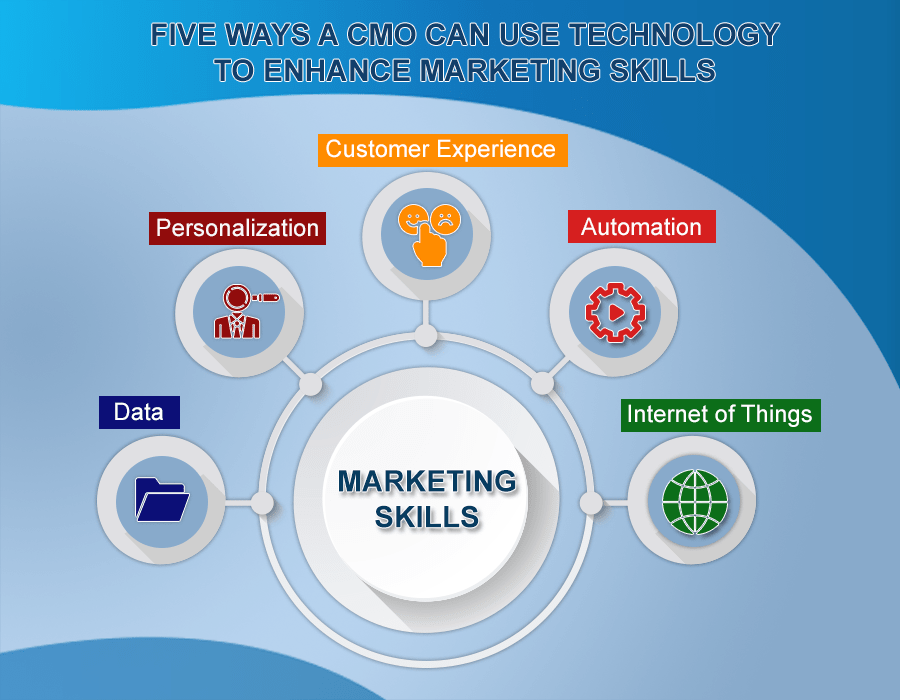
Data
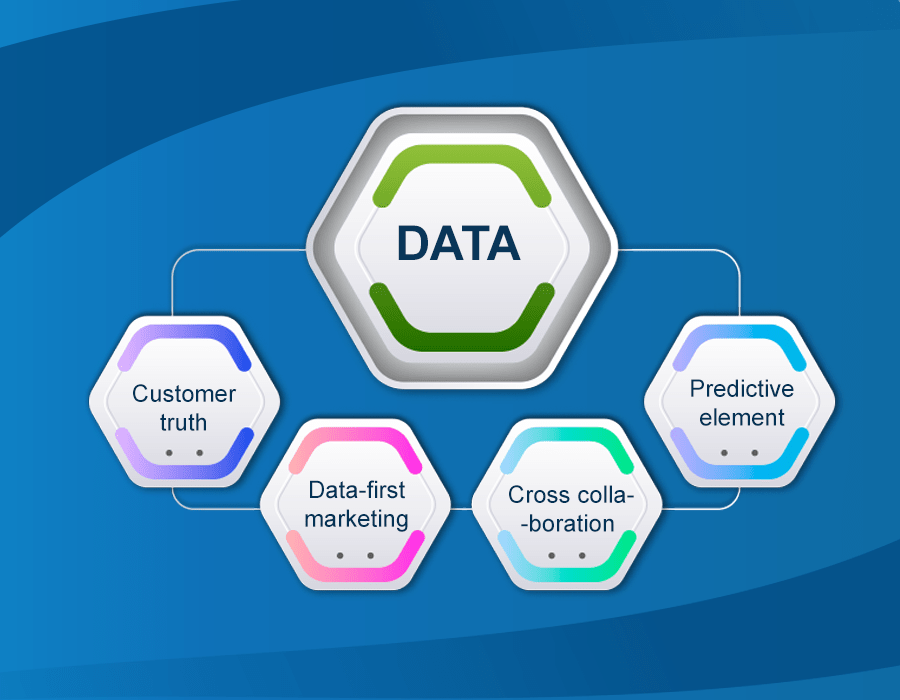
Only 13 percent of marketers remain advanced in CRM integration with data- Dun and Bradsheet, State of b2b marketing data, 2018
1. Customer truth: A CMO collects inputs from psychographics, demographics, firmographics, customer behavior and clickstream using technology. A CMO will derive customer truth based on uniqueness, value, applicability, and privacy.
Customer truth can help the CMO spot position and current status of the customer journey.
2. Data-first marketing: Data-first marketing strategy means utilizing customer data for preparing content for customers. CMO Keith Weed worked with Google’s anonymous search data to develop specific content for an online video channel.
Unilever also developed (Chef Wendy) an automated natural language processing system to help the customers prepare dishes with available ingredients. Unilever launched Chef Wendy through SMS. It enabled them to get their customer preferences.
3. Cross-collaboration: Cross-collaboration is an essential element that reflects coordination. The marketing and sales departments in an organization must always analyze the data insights to improve their ROI and CRM.
Predictive element: Predictive element is essential for a CMO to make an effective future strategy.
- As a CMO, the more you enter customer data into a predictive analytical engine, the more accurate customer insights you get
- Predictive tools help generate a relevant target account list, even with lesser data on the target audience
Personalization
Personalization means blending customer information and technology to customize digital interactions between the customers and the brand.
As a CMO, if you do not personalize your product or service according to customer preference, then it is completely outdated. Personalization of product/service determines how engaged your customer will be.

In 2020, the top channels for connecting with the customers will be World Wide Web (53%), social media (63%), mobile apps (47%) and mobile web (46%). Publishing-centric channels like television, radio, and print scored far lower than the online channels.
1. Purchase intent insight: Instead of using ABM to find out the sales prospects, there is another way. You can collect the purchase intent of customer data. This data can help you narrow-down the opt-in prospects and work with them.
You can later utilize the ABM process on the individual accounts effectively to reduce the wastage of resources.
2. Channels for interactions: Mass media channels like print, television, and radio remain at the bottom of preferences for the marketing leaders concerning personalization.
The top three channels include the World Wide Web, Email and Social media. By 2020, mobile web and mobile apps will overtake email as the top channel for customer personalization.
Marketers prefer to interact directly with the customer rather than using mass media channels for customer interactions.
Customer Experience
Customer experience is a customer’s impression of the brand during all the stages of a customer journey. Improved customer experience determines the customer journey and customer retention.
As a CMO, you may wish to retain your existing customers and acquire new customers. A right customer-experience strategy would improve your personalization and get more customers.
Customer experience would overtake the product and price as the key differentiator of brands. – Walker study, (Customers 2020, A progress report)

1. Omnichannel approach: Marketers use the omnichannel approach to provide the right content to the customer at the right stage. Marketers with technology, perceive a 360-degree view of the customer to spot their position in the customer journey.
Based on the position of the customer in the customer journey, the content marketers prepare the content. In short, you can accurately make customer-centric content.
Businesses adopting omnichannel strategies attain 91 percent greater annual customer retention rates. – Aspect Software, 2014
2. Location-based computing: As a CMO, you can utilize location-based computing to conduct promos for your campaign. You can reach out to customers with personalized offers to boost the outreach of the campaign by merely using location.
Navigation programs can help you retain the existing customers for obtaining valuable information on the customer-purchase intent.
3. Virtual Reality: In virtual reality, you can live and interact with the computer-generated world. You can develop a pre-built dashboard to offer the right services to the customer at the right moment.
You can guide and direct B2B leads to get a seamless experience at multiple touchpoints with a user-friendly virtual reality application.
The economic reality of augmented reality and virtual reality would be $29.5 billion by 2025. – Statista
Automation
Automation is a blessing for marketers who want to escape from repetitive and monotonous tasks that come their way. It enhances their productivity to a greater extent.
Some technologies have turned a trend-setter for automation. Automation in B2B is on a new stage of evolution.
73 percent of companies use automation in email marketing; 26 percent of companies plan to use automation by 2018. – The state of B2B marketing automation, 2017

1. Artificial Intelligence and Predictive analytics: A winning blend of artificial intelligence and predictive analytics helps you to offer personalized customer experience. You can obtain valuable insights from intelligent statistical models and analyze the next move for your campaigns.
The right mix of learning tools and marketing automation can let you upsell or cross-sell smartly, while also improving customer experience.
2. Chatbots: B2B businesses can use chatbots to interact with their target audience and get their requirements fulfilled. Based on your goals, you can assign activities and functions for chatbots to execute. Businesses must decide the method of chatbot creation (building a customer bot from scratch or buying a readymade chatbot software).
You can use email marketing chatbots for conducting customer services campaigns. Chatbots provides coupons, offers, and discounts based on context, location, and timing.
Chief Marketing Officers must map and understand the customer journey accurately, before using a chatbot application. Chatbots helps you provide real-time and proactive emails to existing customers at the right time.
3. Predictive Lead Scoring: Many B2B companies are on an active lookout for predictive lead scoring strategy.
Predictive lead scoring tools help you predict whether the use of algorithm qualifies as a lead. It enables you to work with optimized workflows and assists in converting the right leads.
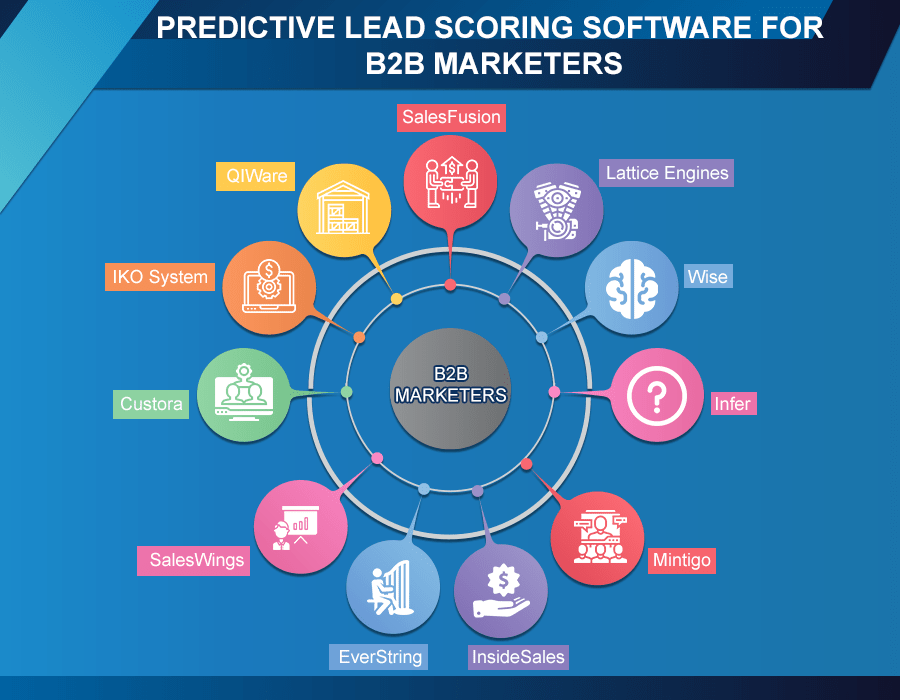
4. Data visualization: Visualization helps you to take a real-time decision based on the customer’s position in the customer journey. Visualizing tools helps you to find out the number of automated workflows and further monitor its performance.
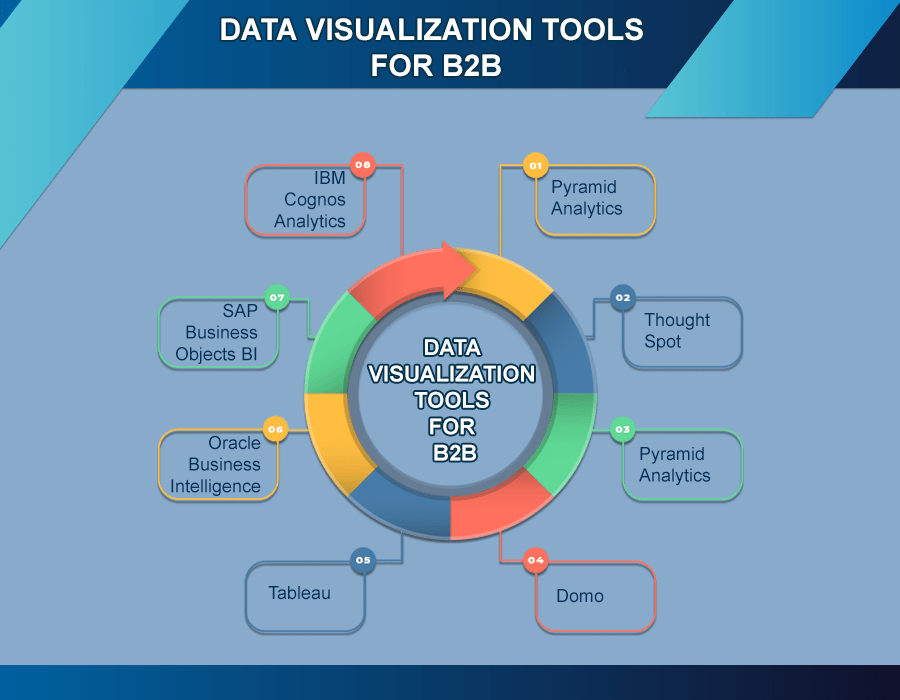
5. Social media marketing integration: CMO can streamline the activities to turn the social media interactions to the account level. You can integrate ABM and social media processes to offer the best social media content based on the responses of the leads.
6. Hyper-personalized content: Hyper-personalized content is a resource for B2B businesses. A CMO must ensure that marketing automation platforms are integrated with customer management platforms to provide hyper-personalized content at ease.
Also read: Interactive Content: 5 Benefits it has for B2B Marketing
Internet of Things (IoT)
Internet of Things is defined as a network of devices that can accumulate, send and transfer customer data, with zero human intervention. These network devices are like inanimate objects.
Connected devices are going to increase to 5.4 billion IoT devices in 2020 from 2.5 billion devices in 2017. – Internet of Things and Hardware Industry Overview, 2016
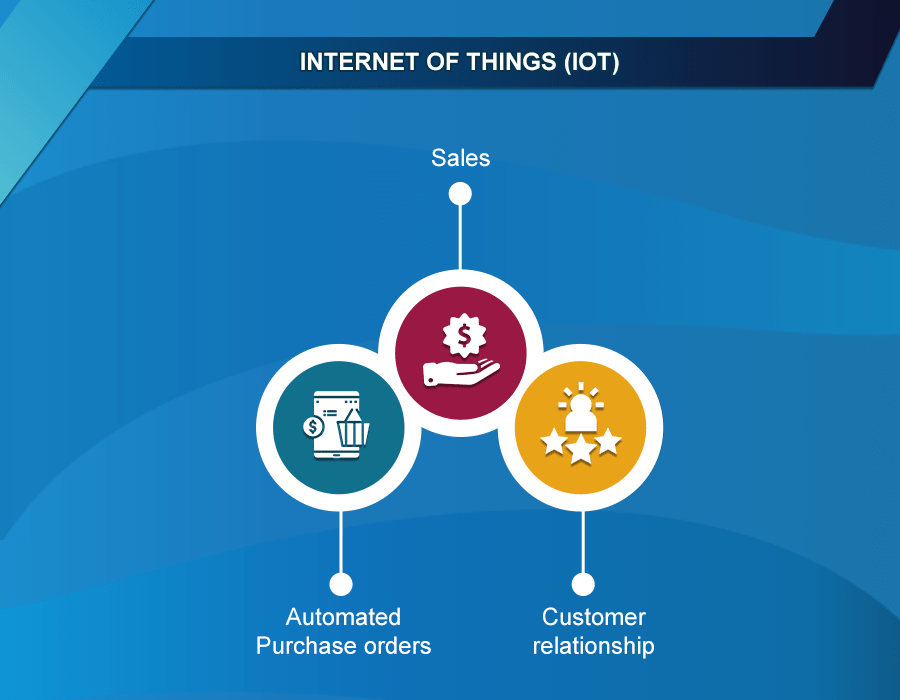
1. Automated Purchase Orders: IOT comes today with the automation functionality for marketers. As a CMO, you can automate B2B services that the customers repetitively demand.
If a B2B marketer is not satisfied or wants more customer data, IOT can automate repurchases or reorders, effectively.
2. Sales: As a CMO, you can enable your marketing team to improve the delivery and timing of the marketing messages, based on the customer journey. You can also analyze behavioral interactions and market forces of a firm.
It offers a clear insight into customers on your offerings. The inputs from IOT can help you to improve your services and adapt your products to the customers’ requirements.
3. Customer relationship: IOT provides you a unified or thorough 365-degree view of customer data. The insights from IOT are valuable and meaningful to the sales rep to prepare the relevant content at the right time.
Conclusion
Kudos! It’s time you join a bunch of marketers and turn out to be a tech-savvy CMO. Well, it’s time for you to stay a few steps ahead, just like that of the wise monk. By leveraging technology, you can achieve success in your field of work. As a Chief Marketing Officer, you must use tech to boost your career to the next level of success.
Please share your opinions on how to utilize technology to enhance the marketing skills of a CMO and the marketing team. To get valuable details on CMO Users Email list, connect with us on email.
For more information, inquiries suggestions and recommendations on the CMO’s tech-enabled marketing contact us on [email protected].
Please share the post with your friends and colleagues. We would meet on another series of posts on Chief Marketing Officers (CMO).




